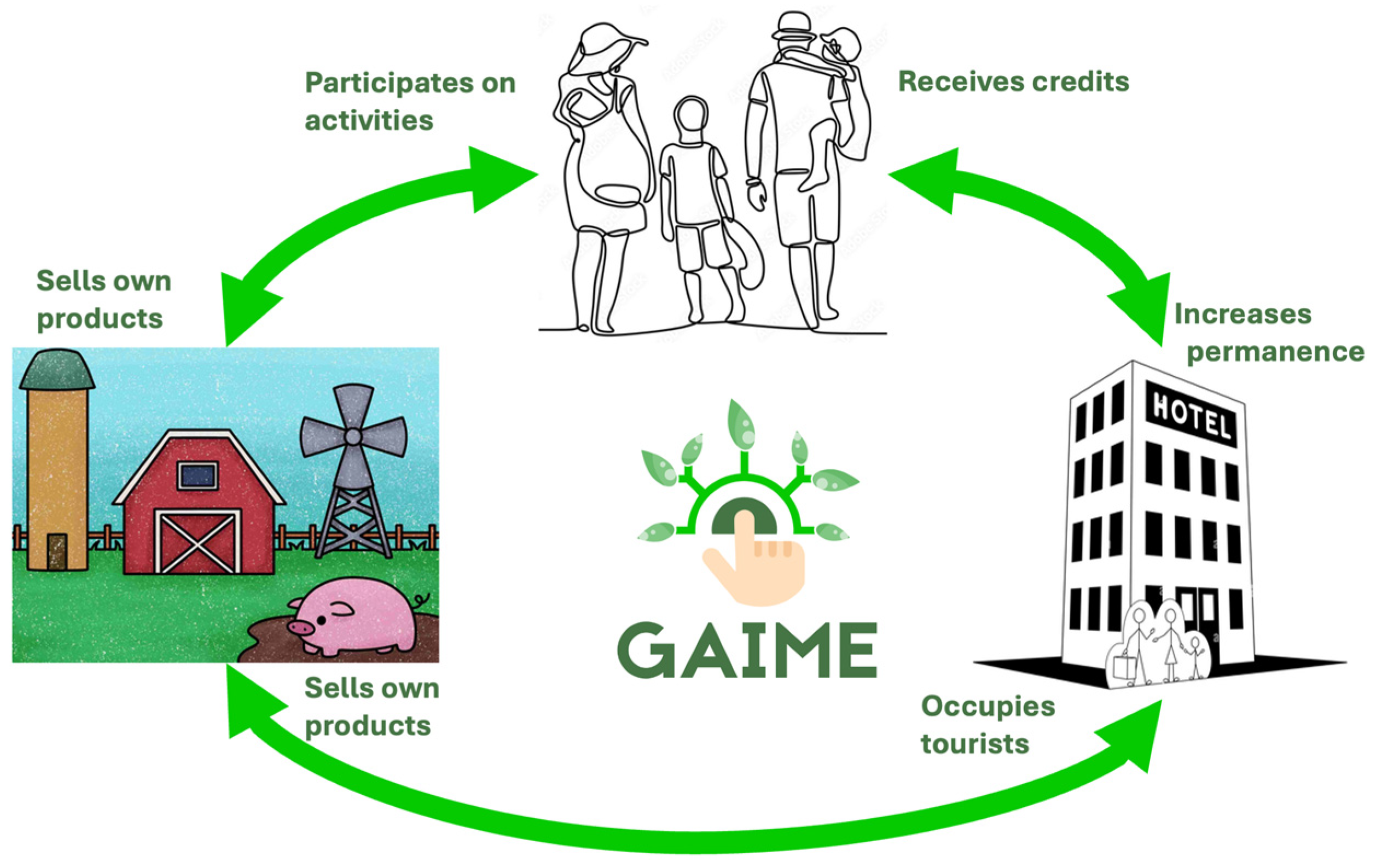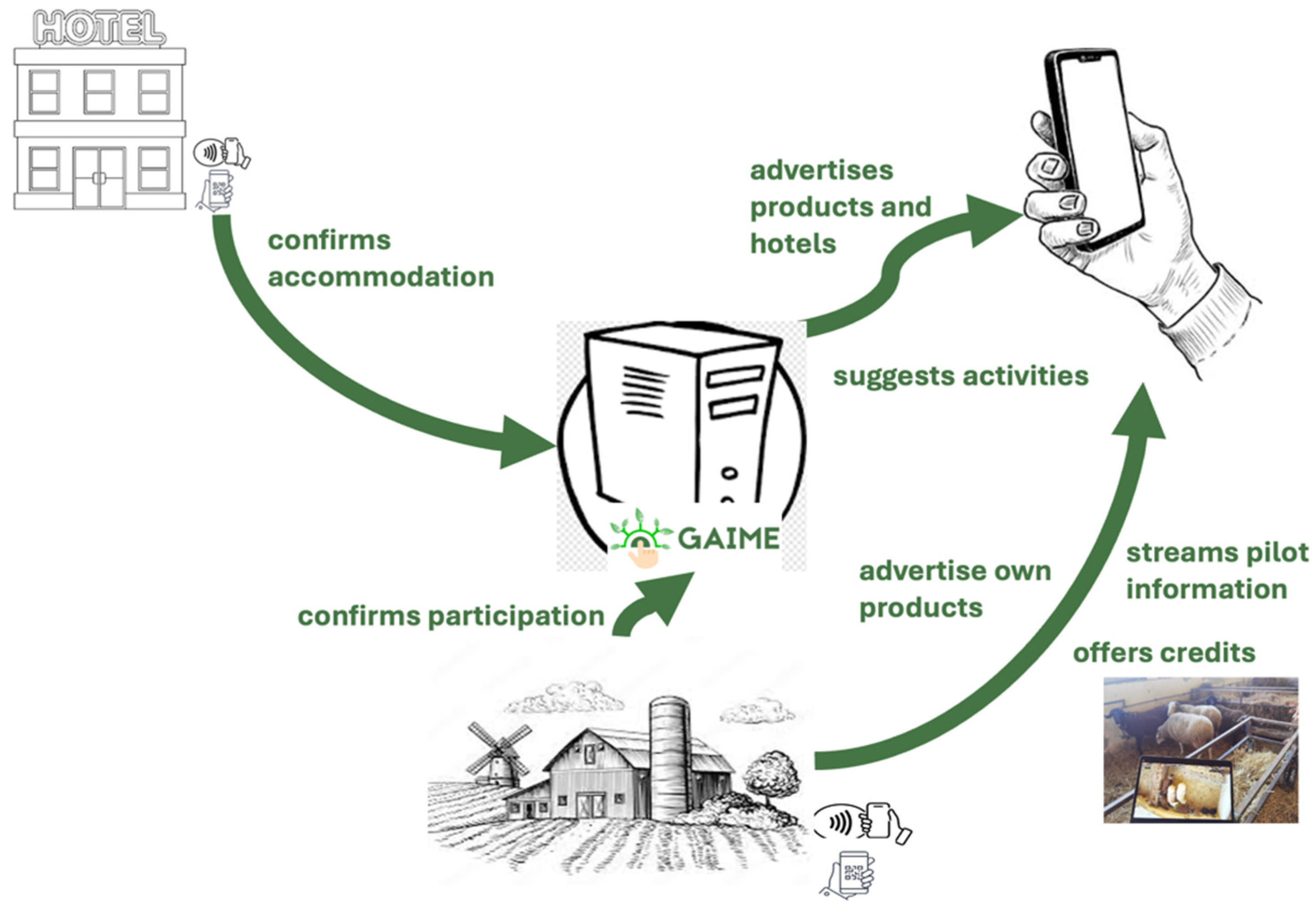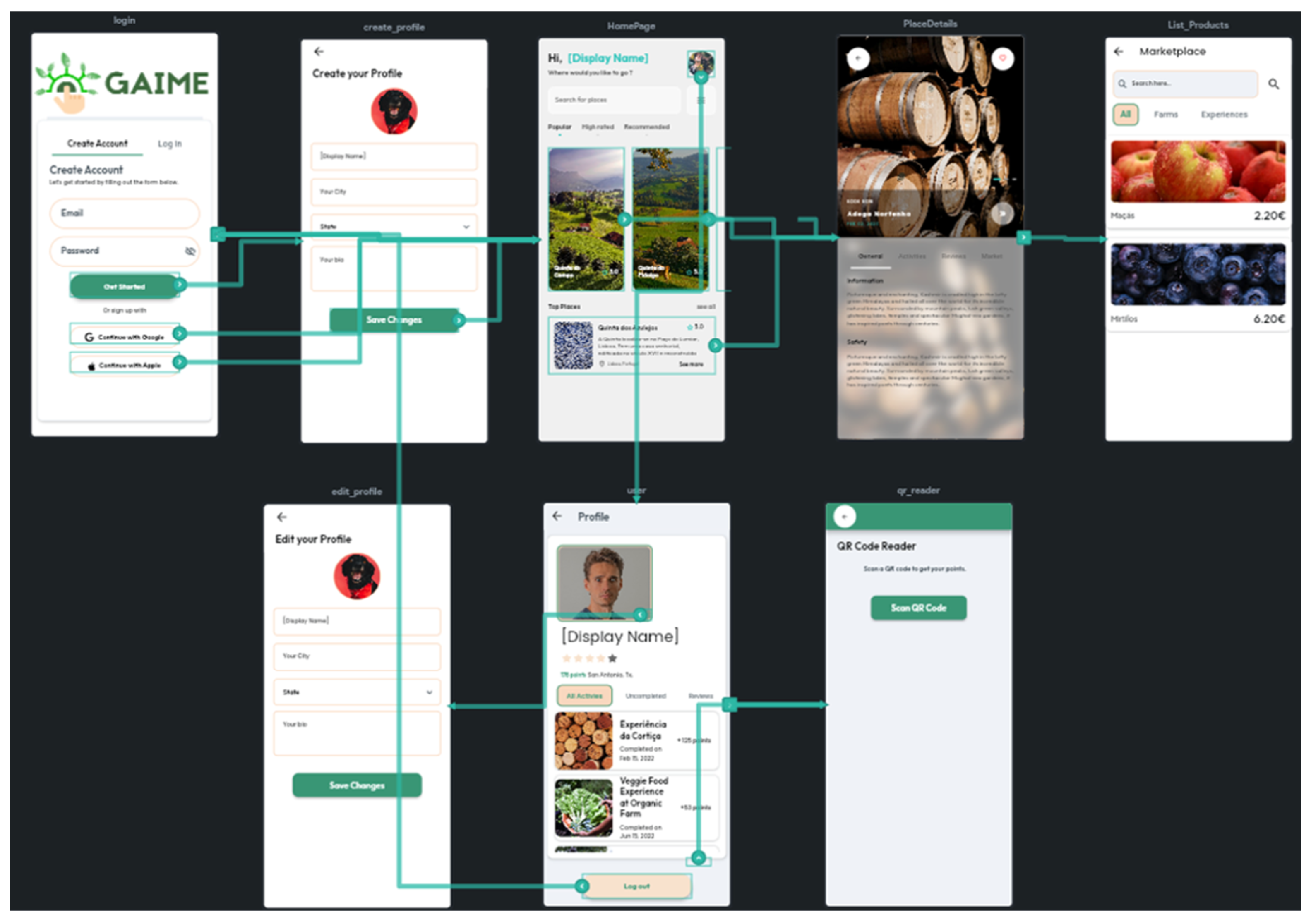1. Introduction
Rural areas have been suffering a process of depopulation, with the loss of the young population and the consequent accelerated aging of residents [
1], due to the lack of active economic structures that ensure income and qualifications for younger people. As a result, many are forced to migrate to more urban regions. The GDP generated by the agricultural sector went from 8.9% in 1980 to 1.6% in 2020 [
2], a sign that production entities were unable to keep up with the generation of added value in the rest of the national economy.
Contrary to agriculture, the tourism sector gained importance in the national economy [
3], having gone from 2% of GDP in 1996 to 6.1% in 2019, being a sector that still presents an enormous export capacity. The existing heritage in rural areas (e.g., houses, farms, etc.) is appealing to the inhabitants of the urban environments [
4], which is a reason why, between 2013 and 2019, rural tourism companies tripled the number of guests. The national statistics base in Portugal, PORDATA, shows that, despite the growth of guests in rural accommodations, the average number of nights in rural tourism remains at 2.2 nights per guest, while villages, hotels, and tourist apartments have an average of 5 nights per guest [
3]. The potential reasons for this may be related with the lack of recreational activities during the accommodation period in such areas. The complementarity of tourist and agricultural activities allows for mutual gains [
5], using local fresh agricultural products in restaurants and hotels, and the use of agricultural tasks and scenarios as a form of entertainment for guests.
Gamification [
6,
7] consists in the application of game mechanisms outside its original domain to promote customer loyalty or to stimulate a certain behaviors or practices. Its roots come from the marketing area, which has developed practices such as loyalty cards, stamp books, and membership rewards, creating a set of approaches that motivate customers to collect points that are exchangeable for presents and gifts. Gamification has enormous potential associated with tourism [
7,
8], and, in the last decade, it has been used to promote destinations, airlines [
9], or even ecological practices in tourism areas [
10]. It can boost agritourism and tourism in rural areas if an appealing and effective approach is taken to engage tourists and to promote agriculture and the local economy.
Initially, this concept of gamification in tourism was essentially based on another development in the use and deployment of information technologies, especially the use of gamified augmented reality (AR) and virtual reality (VR) applications. Incorporating VR will often involve the tourist using headsets in an experience. AR in tourism often involves the use of Quick Response (QR) codes to guide tourists to various points of interest in a destination [
11]. Alčaković et al. [
12] emphasized the contribution of gamification to the tourist experience in a way that remains in the subconscious of each person to improve their tourists’ experiences, “making tourists immerse themselves in a simulated world of travel”, “which is fantasy and fun in nature”.
Xu et al. [
9], providing a broad overview of literature and practical scenarios, also pointed to the benefits of tourism gamification, including rural environments, but, unfortunately, they did not consider agrotourism scenarios. According to Dolores et al. [
10], a participatory experience can be elevated by gamification, so that it proves to be truly motivating and enjoyable for the individual. Furthermore, applying gamification to environmental interpretation contributes to filling the gap of interest identified by the literature.
The main objective of the GAIME project [
13] is to promote synergies between touristic and farming operators so to boost economic activity in rural areas, and thus to reduce the abandonment of rural territories. In operational terms, the project aims to (i) digitize farming activities using intelligent technologies to optimize farming activities, thus allowing for increased profits; (ii) explore the agritourism approach and to develop a digital platform that allows for a first virtual experience of what it will be like to visit the farms; (iii) use a platform as a means of gamifying tourist participation in farm activities, offering participation prizes and promoting the integrated tourism offer to urban residents.
2. A Gamification Scheme to Boost Agritourism in Rural Areas
The strategy for fostering synergies between agricultural and tourist activities, illustrated in
Figure 1, consists of collaboration between operators from both sectors, thereby promoting an enrichment of the tourist experience during their stay in the region, using IoT technologies.
Tourism sector operators use agricultural activities as a form of entertainment for their customers, allowing for the introduction to rural areas, agricultural activities, and local fresh produce with added value. The promoted activities allow for contact with crops, such as horticultural or fruit crops, with animal and livestock activities, and with local processing activities, such as cheese dairies or local sausage factories. Agricultural operators, in turn, sell local products for consumption in tourist establishments, allowing for the creation of meals using fresh, local, and value-added products, as well as the resale of their products, such as baskets of vegetables, fruits, cheeses, or sausages. Tourists receive a set of entertainment offers that allow them to enrich their period of stay in the territory, and whose participation allows them to receive gifts and discounts both from agricultural operators and the hotel sector.
The dynamization of this strategy provides gains for all actors, as the tourist gains a richer tourist experience and a deeper knowledge of the territory; the agricultural operator then has a means of advertising their products and gains direct flow channels for the goods produced; the hotel operator gains a channel to advertise its offer, as well as an extension of the tourist’s period of presence in their accommodation.
Additionally, GAIME’s action plan will be composed of the following verticals: (i) the digitization of agriculture and livestock through the use of sensorization, IoT, and big data, analyzing the reduction in production factors, raw materials, and labor, thus making these activities more attractive and promoting the creation of SMEs in these sectors; (ii) the exposure of sensor data through the web and social networks, thereby creating relationships with the inhabitants of urban areas; (iii) promoting cooperation between agricultural and tourism operators as a way of boosting the local economy and increasing producers’ income; (iv) spreading the knowledge to the producers through the development of a content-sharing platform and holding technical training sessions.
In order to implement the agritourism boosting strategy, the project includes the implementation of the following four pilots in Portugal: (i) Baião (NUTS (Nomenclature of Territorial Units for Statistics) III-Tâmega and Sousa), (ii) Mogoudouro (NUTS III-Terras de Behind the Montes), (iii) Guarda (NUTS III-Beiras and Serra da Estrela), and (iv) Coimbra (NUTSIII-Coimbra Region), where all agricultural operators, as well as local tour operators, will be identified and invited to participate. Additionally, the agricultural processes to be monitored in each of the four territories were identified and will be implemented through local pilots.
2.1. AgroturGame Platform
GAIME’s dynamization strategy is promoted through gamification techniques implemented by a computer platform named AgroturGame, whose interaction is illustrated in
Figure 2. AgroturGame tracks tourists staying in local accommodation units, tracks participation in agricultural activities and experiences, suggests participation in new activities, advertises agricultural products and local accommodations, and offers gifts and discounts depending on the successful participation in the activities offered.
As a way of taking the agritourism experience outside the rural area and extending it beyond the stay, the platform continues to present new touristic offers to past tourists, as well as stream information from agricultural holdings, such as videos of the phenological evolution of fruit trees, monitoring the activity of livestock animals, and others. Previous tourists might even be able to follow up on the evolution of their outcomes of realized participation activities (i.e., livestreams or photos of a planted tree), thus promoting ecotourism activities and raising awareness to agricultural and ecological activities.
The interaction between the platform and the user is carried out through a smartphone app (whose story board is illustrated in
Figure 3) that receives notifications from the platform with accommodation offers, hotel activities, and gifts, and which, through sensors such as NFC tags and QR codes, tracks the presence of tourists in accommodations and activities offered by agricultural actors.
The application has a set of different profiles, such as for the tourist, the touristic operator, or the agricultural operator, which allow for a different interaction with the platform. The tourist uses the application as part of the gamification process, thus proving their participation in the proposed activities, to receive notifications of offers and vouchers, and to maintain contact with the information streamed by the project pilots. Operators, whether livestock or tourism operators, use the application to edit the content associated with their entities.
2.2. GAIME Pilots
Baião, situated in the Tâmega e Sousa sub-region of Portugal, embodies a rural charm that is abundant in agricultural landscapes, historical significance, vibrant cultural heritage, exquisite gastronomy, and renowned wines. The Baião pilot project encompasses various tourist engagements, such as outdoor escape rooms featuring interactive checkpoints. These checkpoints will weave the rich tapestry of the region’s history and culture through audio guides, immersing participants in an authentic experience. Additionally, the project will offer hiking trails traversing agricultural expanses and showcasing local points of interest. These routes will be digitally mapped on the platform, allowing users to virtually explore them in advance and select those of particular interest. Furthermore, the project will involve the real-time monitoring of a sheep herd, furnishing insights into their behavior and well-being through the AgroturGame platform.
Mogadouro, situated in the rural expanse of Terras de Trás-os-Montes within the district of Bragança, focused its pilot on goat cheese production activities. The emphasis was on monitoring goats [
14] and overseeing the cheese production process, spanning from milking to the creation of the final product. Furthermore, GAIME plans to showcase the involvement of the Mirandês Donkey via the AgroturGame platform during various fairs and events. This initiative aims to draw in tourists and offer sponsorship opportunities for these animals.
The Guarda pilot project will integrate two sheep farms into the AgroturGame platform, facilitating the sharing of monitoring data from a herd alongside continuous video footage. This setup enables the real-time observation of animal activity and behavior by using wearable collars [
15]. Additionally, the pilot will establish connectivity with an artisanal cheese factory, allowing for the monitoring of the cheese production process, from ordering to the acquisition of the final product.
Finally, in Coimbra, a pilot will be distributed across two locations in the region and will include an area dedicated to outdoor horticulture, measuring 2.5 ha and 2000 m2 of under-cover horticulture, distributed across six greenhouses. This will be monitored through image capturing, showcasing the evolution of some vegetable species, such as potatoes, beef heart tomatoes, green beans, courgettis, and cabbages of different regional varieties. In the second place, fruit species will be monitored, namely, apple, pear, peach, and orange trees, as well as vineyards.








